Part 1: Evidence and reflection on my learning in EDCI 339 (Option: by outcomes)
In this part, I will be mainly using some illustrations, such as direct quotes and my reflection in my own post, to demonstrate my accomplishments in all learning outcomes that listed in this course.
Learning outcome #1—Describe the potential of human-centered learning in distributed and open learning contexts
I met this learning outcome, as I got some meaningful quotes from Jesse and Regan’s paper from Topic #1, after carefully reading:
“One of the most problematic aspects of edtech, and least addressed from a policy perspective however, involves the capability of edtech to deliver more personalized learning based on the needs and skill levels of individual students.” (Regan, 2018, p. 168)
In my own understanding and reflection, since people are born to be different, it is quite necessary to give distinct personalized-study-plans to students of different levels, such that these students enjoy higher improvement in both learning and efficiency.
Another important quotes that are highly relevant to learning outcome #1 are:
“The last 10 years have witnessed an explosion of new educational technologies (edtech), some touting amazing potential to reach the next generation with new learning methods that will teach not only content, be it history, mathematics or engineering, but also intra- and inter-personal competencies, such as resilience and teamwork.” (Regan, 2018, p. 167)
and “Edtech companies recognize the huge market offered by K-12 education—an arena that has a vast and renewable population base.” (Regan, 2018, p. 167)
Using my own critical thinking skills, these two quotes combined describe an emerging trend in which the human centered learning is gradually replacing the traditional teaching method that focuses on didactic. This potential does develop. However, like I mentioned in the first paragraph of Topic #1 discussion, this potential is always accompanied with the risks or trade-offs, particularly the issue of privacy.
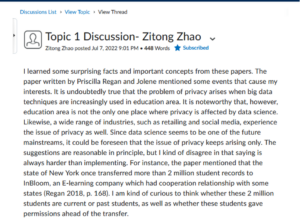
I also learnt from Morris and Stommel’s book that “educators and students alike have found themselves more and more flummoxed by a system that values assessment over engagement, learning management over discovery, content over community, outcomes over epiphanies” (Morris & Stommel, 2018). This point seems to be irrelevant to learning outcome #1, but it is indeed relevant. K-12 period is the period at which children are “faster than” college students in developing the curiosity and discovery towards knowledge. In addition, unlike college professors who carry out the task of producing knowledge, K-12 instructors have more time and space to utilize new educational technologies. These two reasons together explain why the above fact that Edtech has vast customer base in K-12 schoolings. Like what I may be repeating multiple times in the rest parts of this portfolio, open learning does not fit very well in the natural science and engineering courses. One main reason is that the knowledge in natural science and engineering courses are relatively profound. Without strong foundation in math and physics, students can fall behind very easily even if the students may have access to open learning resources.
Through the friendly exchange of ideas at Brightspace, I deepen my own understanding for learning outcome #1. For instance, one of my pod partner Mengqi exchanged some ideas on the discrimination problem which may be occurred by personalized learning. He claimed that because personalized learning can classify students by race, gender, standing, and so on, personalized learning generates discrimination problem. I admit that personalized learning does generates discrimination, but discrimination in the context of education area may stand more for differentiation. For instance, suppose I am an average student in calculus course. I expect to have access to more “entry-level” materials, rather than “advance version” materials, from personalized learning. I admit that under this case I may be somewhat discrimination as being classified as average. But who cares, so long as he or she experiences substantial improvement in learning. I understand that anything may be double-edge sword, and open learning is not an exception.
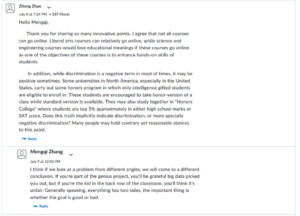
By completing these activities, I learned a lot. Please see the evidence above. In both in-text analysis above and Brightspace screenshots. I critically reflected on some important terms, such as open learning, pedagogy, personalized learning, privacy, discrimination, tradeoffs in Edtech, and so on.
.
The things I learned matter to me because 1) as a current student, I usually encounter dilemmas in choosing between in-person tutorials and online resource. For instance, suppose that I am stuck in some physics problems. Do I go to in-person tutorial tomorrow, or watch online tutorial? Like I claim many times, the knowledge in natural science is usually profound, such that most of time neither TA at in-person tutorial nor the authors in online tutorial, such as Youtuber who upload video-clips, can correctly answer my inquires right away. If the potential of open learning keeps developing and the OER-enabled sources are proved reliable, I may switch my focus to this developing because I learn more and save time more.
Learning outcome #2 Explore and engage with current literature on the distributed and open education movement
&
Learning outcome #3 Critically reflect on and articulate concepts around modality, pedagogy, and access, including distributed and open learning theory, online and open learning history, privacy laws, online learning communities, open research, and open data.
I combined these two learning outcomes together, as a lot of readings in Topic #1 and Topic # have some evidence that belong to both learning outcomes. Again, I will be mainly using direct quotes from the assigned readings, reflection, WordPress screenshots to display that I met both learning outcomes above.
I learnt a lot in the paper by Major’s book, because it is written for the point of view of students and introduces some concepts, which belong to learning outcome #3 and connect closely to real life of college students. For instance, 5 essential structural elements of online courses are: enrollment, amount, timing, platform, and pathway. 1) Two extremes of Enrollment are open and close. Regardless of online or not, almost all courses that offered by UVic are closed. For instance, in this EDCI 339 course, no students are from other universities. On the other hand, MOCC is a typical example whose enrollment is open. According to Major, “the core feature of these courses is that they are available to anyone who has adequate technological tools, who wishes to learn something about the topic, and who has the time to participate (Major, 2015, p. 78). 2) Amount refers to, in my own words describing the idea from Major’s book, the percentage of activities that are held via internet. According to Major’s book, when 80% or more of the course happens on the Internet, this course may be considered “online”; When 30%–79% of the course happens on the Internet, this course may be considered “hybrid” or “blended”. When 1%–29% of the course happens on the Internet, this course may be considered “web-assisted”. This information not only relates to modality of online learning in learning outcome #2, but also attracts my interests, which I will be discussing in the upcoming “why it matters to me” portion.
3) Timing: this element may have two options: asynchronous and synchronous. EDC 339 is apparently asynchronous. Because of the pandemic, most courses in Canadian universities are also offered in asynchronous basis. 4) Platform: According to Major’s book, “a platform provider offers a prebuilt product that can handle many online learning functions, including course administration, documentation, tracking, reporting, and delivery (Major, 2015, p. 78). The Brightspace, which UVic is using, and the Canvas, which UBC is using, are apparently the application of “Platform”. 5) Pathway: this concept has two extremes: centralized or distributed. In the standard of distributed learning, “students can interact with it or each other and the course content in different ways”. (Major, 2015, p.86).
I learnt the history of opening and online learning via Edtech Timeline and the index of Martin Weller’s book 25 Years of Ed Tech. I also learnt a lot from the interactions with pod peers via reading post and reply. For instance, Yilin Wang briefly discussed the real world connection between pandemic teaching and 5 structural elements in Topic #2 blog. In my reply to her post, I wrote the following:
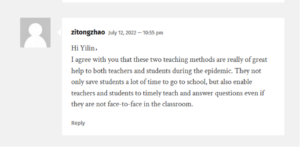
In the topic #2 post of Lei Han, another pod peer, he reflected mainly on “Platform” by linking platform to real-world study. I cannot agree more on the claim that a good platform does improve efficiency and save time. In the reply to his post, I wrote:
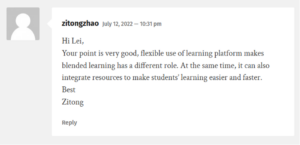
In my own post for Topic #2, I put forward an important point that online courses are neither for all student nor for all subjects.
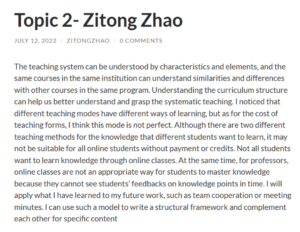
By completing these activities, I learned a lot of the concepts and applications in the field of online and open learning. I also reflected these concepts in both discussions above and the blog posts that I did. Moreover, I critically evaluated the applicability of online courses under normal time and “pandemic time”.
.
The things I learned matter to me because 1) I noticed some meaningful truths after I combined the contents from all 4 topics. Online courses are not for all students and all subjects. Some subjects, especially social science course, make nearly no difference between online teaching and in-person teaching. Natural science courses, however, frequently require students participate in ether on-site experiments or hands-on activities. So, these natural science course cannot go fully online. So, when deciding their courses, college instructors must carefully think about the extent to which the 5 structural elements are emphasized.
The things I learned matter to me also because 2) Sometimes my email account received some ads in which some top universities were selling short-term MOCC courses. I used to ignore them. After reading Major’s book, I found out some pros that I have not known before. If time permits, I may consider enrolling in one or two MOCC courses.
Learning outcome #4— Examine and reflect upon the potential for equitable access for all learners in online and open learning contexts.
I met this learning outcome by carefully reading the assigned articles. For instance, from Mays’ article, I learnt that the cores of open pedagogy and that access is essential to education enterprise. Also, OER-enable pedagogy help fulfills the cores of open pedagogy: “When we talk about OERs, we bring two things into focus: that access is critically important to conversations about academic success, and that faculty and other instructional staff can play a critical role in the process of making learning accessible” (Mays, 2017). “OERs invite faculty to play a direct role in making higher education more accessible” (Mays, 2017).
From Chris Gilliard’s blog post, I learn that digital technologies in the modern period have substantial impacts on the issue of access. “It may have to do with the growing sense that digital justice isn’t only about who has access but also about what kind of access they have, how it’s regulated, and how good it is”(Gillard, 2016).
From Kral’s article, I learnt that the access to learning resources is an important issue. Good learning resources have better to encourage learners to learn, engage in group/community, and practice interpersonal skills.
I also participated in myself and pod peers’ posts and reply to consolidate my understanding in this learning outcome. In my own blog, I wrote:
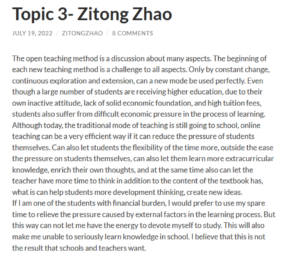
Lei Han in his post points out personal reading’s impacts on the issue of access, in my reply to his post, I wrote:
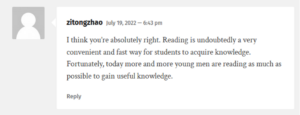
Moky in his topic 3 post noticed impacts of financial burdens on access. In my reply to his post. I exchanged some ideas with him:
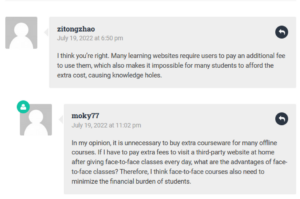
By completing these activities, I learned that issue of access is involved with various sections and details. Since OER is still developing, it serves as an option for both students and educators to reduce costs and enhance the extent to which access to education is available. I also learnt that Internet has pros and cons, as far as the topic of access is concerned.
The things I learned matter to me because I, as a current student, always expect to have access some education resources that are accurate, low-cost, and convenient. After accomplishing this learning outcome, I realize that not all open learning resources are good, and that not all close learning resources are of low- quality. In other words, when I am about to choose learning resources, I have better to apply case-by-case basis.
Learning outcome #5— Conduct research into and critically reflect upon emerging and future educational technologies.
I met this learning outcome by doing Digital Equity and Perspective Pod Project with my pod peers. Lisa, the persona whom our group created, has some strengths and weakness. We choose open learning as the solution to help her grow more efficiently. The pitch result is as follows:
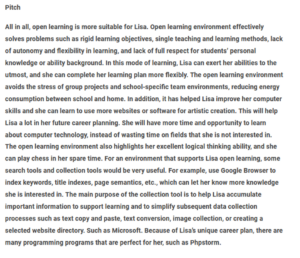
By completing these activities, I learnt that personalized setting and case-by-case analysis are needed when applying open learning to different individuals. During the process of this pod project, I also learned that there are so many considerations in open/distributed learning, such as issue of equity and student’s cultural background, , as well as student’ strength and weakness.
The things I learned matter to me because I enhance my interpersonal skills, discovery, and hands-on skills, which are all attributed to the objectives of pedagogy claimed by Major. The things I learned matter to me also because this project reminds me of a useful truth: like I claim and reflect repeatedly in topic #4 discussion, the applicability of open learning depends on the subject and institution. But this pod project indicates that applicability of open learning also depends on students’ characteristics. In the real world, I am facing some opportunities from open learning, such as on-site IELTS course outside UVic and online Python course also outside UVic. When I am selecting between them, they are indeed selecting me at the same time, because applicability of open learning varies across students.
Learning outcome #6— Practice digital, networked, and open literacies in support of learning about distributed and open learning.
Professor Banow gave the following meaningful differentiation among concepts in his post.
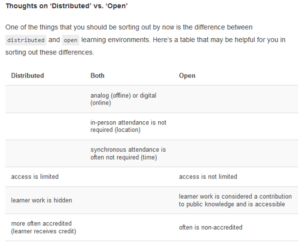
At the very beginning of this course, I partipated in some activities in Brightspace where belongs to distribtuted learning:
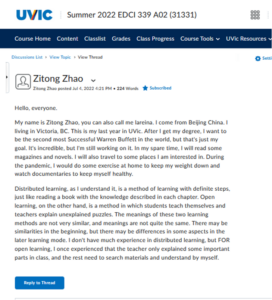
Then, we students swiched to WordPress where belongs to open learning domain. I actively posted my blogs and replies.
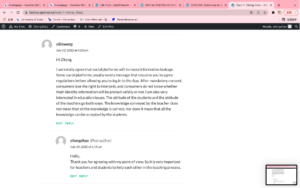
I also used Mattermost software:

By completing these activities, I acquired some hands-on experience and, more importantly, deepened my understanding on the concept of Platform that mentioned in Major’s book.
The things I learned matter to me. In the modern period, it is quite necessary for both parties of educators and students to equip with latest apps and platforms, such that educational practice functions better in the areas of engagement and community.
Part 2 Showcase Blog Portion
Original blog (topic# 3 discussion)
Showcase blog (revisions for topic #3 discussion)
Reasons for editing: the original topic #3 post was not well-written. Because I received friendly feedbacks from Professor Banow and read further the assigned materials, I decided to revise topic #3 in my showcase blog by recalling and reflecting key ideas in a clear and logical way. In addition, some material from latter topic #4 help me to understand further for topic #3.
Contents changed: I explicit recall and reflect the meanings of open pedagogy and OER-enabled pedagogy. I also examine the potential connections between these two concepts by using both assigned readings and real-world reflections.
Reference Lists
Regan, P., & Jesse, J. (2019). Ethical challenges of edtech, big data and personalized learning: Twenty-first century student sorting and tracking. Ethics and Information Technology, 21(3), 167-179. DOI: 10.1007/s10676-018-9492-2
Morris, S. M., & Stommel, J. (2018). An urgency of teachers: The work of critical digital pedagogy. Hybrid Pedagogy.
Major, C. H. (2015). Teaching Online – A Guide to Theory, Research, and Practice. Retrieved from http://ebookcentral.proquest.com/lib/uvic/detail.action?docID=3318874 (pp. 76-108)
Mays, E. (Ed.). (2017). A guide to making open textbooks with students. Rebus Community.
Gilliard, C., & Culik, H. (2016, May 24). Digital Redlining, Access, and Privacy. Common Sense Education.
Kral, I. & Schwab, R.G. (2012). Chapter 4: Design Principles for Indigenous Learning Spaces. Safe Learning Spaces. Youth, Literacy and New Media in Remote Indigenous Australia. ANU Press. http://doi.org/10.22459/LS.08.2012
Wiley, D. & Hilton, J. (2018). Defining OER-enabled Pedagogy. International Review of Research in Open and Distance Learning, 19(4).